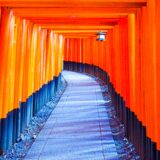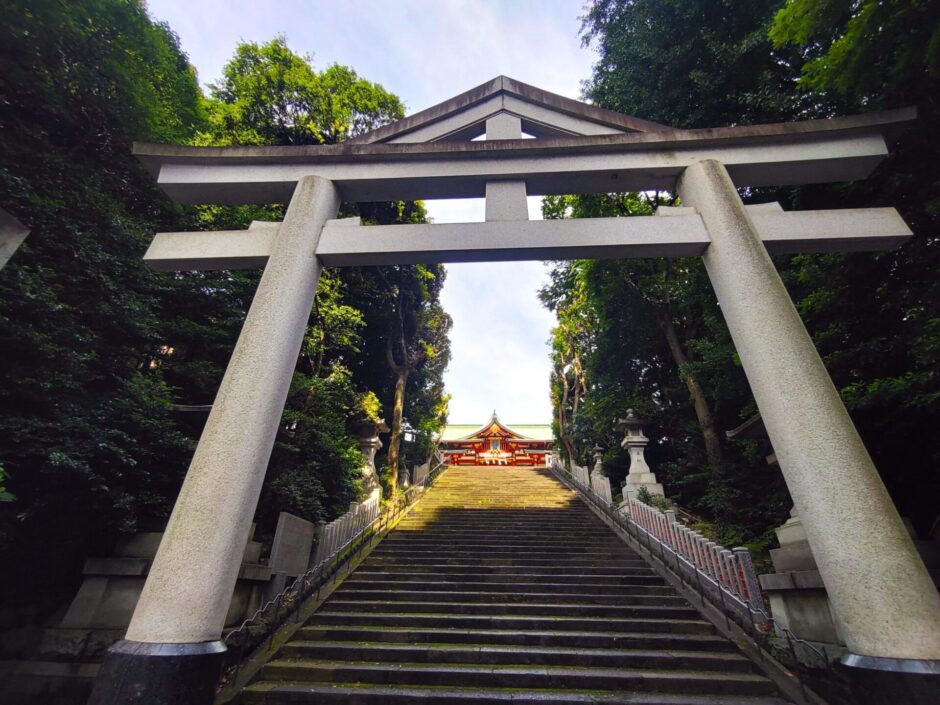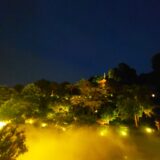目次
- 【Hie-jinja Shrine summary】
- 【Hie-jinja Shrine Omotesando Avenue】
- 【Hie-jinja Shrine Precincts cogon grass ring (through which people pass during summer purification rites)】
- 【Hie-jinja Shrine main shrine】
- 【Hie-jinja Shrine Sannou Bridge road approaching a shrine】
- 【Hie-jinja Shrine Inazuke entrance road】
- 【Hie-jinja Shrine torii corridor】
- 【Hie-jinja Shrine precincts Sanno Inari Shrine】
- 【Hie-jinja Shrine GOSHUIN】
- 【Hie-jinja Shrine Nearby attractions】
- 【Hie-jinja Shrine Access】
- Manager’s Comments
- Hie-jinja Shrine
【Hie-jinja Shrine summary】
Hie-jinja Shrine is said to have originated in 1478, when Ota Dōshō built Edo Castle (to protect the back gate of Edo Castle), he invited Kawagoe Hie Shrine to the shrine. Hie Shrine was the guardian deity of Edo, and after Tokugawa Ieyasu established the shogunate, it was carefully protected by the shogunate family. However, it was moved outside Hanzomon Gate during the reconstruction of Edo Castle and was destroyed by fire in the Great Meireki Fire. It was later rebuilt in its present location. However, it was again destroyed by fire during the Pacific War. It was reconstructed in 1958. The shrine is also famous as the site of the Sanno Festival, one of the three major festivals in Edo, and one of the ten shrines in Tokyo.
The deities are Oyamakui, Kunino-tokotachi-no-mikoto, Izanami no-mikoto, and Tarashinakatsuhiko no-mikoto. The main shrine is Hiyoshi-taisha in Shiga, which is a branch of Oyamakui no Kami. Oyamakui means the god who drives a stake into a large mountain, i.e., the god of the owner of a large mountain, and is the landowner god of the mountain.
【Hie-jinja Shrine Omotesando Avenue】
The torii of Hie Shrine is a unique torii called Sanno Torii (Gassho Torii). The triangular shape on top of the shagami tree is said to represent the union of Shintoism and Buddhism (the womb world and the vajrayana world in Buddhism, and the unity of Shintoism). It is also said that the character for “Sanno” is hidden inside. The approach to the shrine is from the direction of Nagatacho and the Diet Building.
![Hie-jinja Shrine and Sanno Inari Shrine [Tokyo] DSC 0491 1024x768 - Hie-jinja Shrine and Sanno Inari Shrine [Tokyo]](https://japan-shrine.info/wp-content/uploads/DSC_0491-1024x768.jpg)
It is a steep and quite an ascent up 53 stone steps from the torii gate in front, but it is splendid and solemn.
![Hie-jinja Shrine and Sanno Inari Shrine [Tokyo] DSC 0487 1024x768 - Hie-jinja Shrine and Sanno Inari Shrine [Tokyo]](https://japan-shrine.info/wp-content/uploads/DSC_0487-1024x768.jpg)
After climbing the stairs, you will see the Shinmon Gate. The building in the back is the building of PG Friendly Partners Corporation, an American company and one of the world’s largest financial service organizations. As is the fate of urban shrines, the view from Omotesando is disappointing…
【Hie-jinja Shrine Precincts cogon grass ring (through which people pass during summer purification rites)】
![Hie-jinja Shrine and Sanno Inari Shrine [Tokyo] DSC 0485 2 Object Removal 1024x663 - Hie-jinja Shrine and Sanno Inari Shrine [Tokyo]](https://japan-shrine.info/wp-content/uploads/DSC_0485-2_Object-Removal-1024x663.jpg)
Passing through the shrine gate, the main hall of the shrine appears, a space that one would not expect to find in an urban setting, and a thatch ring has been set up at Choto Hie Shrine as well. Diving through the thatched rings is intended to purify one’s sins and impurities for six months, and to pray for good health and protection from bad luck.
【Hie-jinja Shrine main shrine】
![Hie-jinja Shrine and Sanno Inari Shrine [Tokyo] DSC 0474 1 1024x768 - Hie-jinja Shrine and Sanno Inari Shrine [Tokyo]](https://japan-shrine.info/wp-content/uploads/DSC_0474-1-1024x768.jpg)
The main shrine pavilion is very nice with its bronze roof and vermilion color. The building to the left of the main hall is the prayer hall where prayers are offered… GooleMap shows the main hall as the prayer hall…
![Hie-jinja Shrine and Sanno Inari Shrine [Tokyo] DSC 0472 1 1024x768 - Hie-jinja Shrine and Sanno Inari Shrine [Tokyo]](https://japan-shrine.info/wp-content/uploads/DSC_0472-1-1024x768.jpg)
In front of the main shrine is not a guardian dog, but a messenger of God called “Masaru,” clad in a red cloth. The word “Masaru” means “to win” or “to get rid of evil,” and the sound “en,” which is read phonetically, is believed to be a god of luck, protection from evil, and matchmaking.
![Hie-jinja Shrine and Sanno Inari Shrine [Tokyo] DSC 0482 1024x768 - Hie-jinja Shrine and Sanno Inari Shrine [Tokyo]](https://japan-shrine.info/wp-content/uploads/DSC_0482-1024x768.jpg)
There is a wisteria trellis in the precincts of the temple. The wisteria trellis is usually at its best from late April to early May. The wisteria trellis was green because the wisteria season had passed, but I think it would be magnificent if it were in bloom.
【Hie-jinja Shrine Sannou Bridge road approaching a shrine】
![Hie-jinja Shrine and Sanno Inari Shrine [Tokyo] DSC 0496 1024x768 - Hie-jinja Shrine and Sanno Inari Shrine [Tokyo]](https://japan-shrine.info/wp-content/uploads/DSC_0496-1024x768.jpg)
This is the approach from the direction of Akasaka Station. The Sanno-bashi approach is an urban approach with an escalator by the stairs and an escalator to the shrine. From this viewpoint, the approach is in good harmony with the urban buildings. It is thought that the designers must have put a lot of thought into the design. Just riding the escalator with a sense of openness is enjoyable.
【Hie-jinja Shrine Inazuke entrance road】
![Hie-jinja Shrine and Sanno Inari Shrine [Tokyo] DSC 0758 1024x768 - Hie-jinja Shrine and Sanno Inari Shrine [Tokyo]](https://japan-shrine.info/wp-content/uploads/DSC_0758-1024x768.jpg)
If you are coming from the direction of Akasaka-mitsuke Station, you will see this torii gate. You can enter the Inazuke approach from here.
【Hie-jinja Shrine torii corridor】
![Hie-jinja Shrine and Sanno Inari Shrine [Tokyo] DSC 0479 1024x768 - Hie-jinja Shrine and Sanno Inari Shrine [Tokyo]](https://japan-shrine.info/wp-content/uploads/DSC_0479-1024x768.jpg)
The Inari approach behind the main shrine is a popular photo spot and attracts many foreign tourists. The row of red torii gates is tasteful and looks like the original Fushimi Inari Taisha, albeit on a smaller scale. The rows of red torii gates are fantastic.
 Fushimi Inari-taisha Shrine [Kyoto]
Fushimi Inari-taisha Shrine [Kyoto]
The Sanno Inari Shrine, Otome Inari Shrine, and Higashi Fushimi Inari Shrine are the most spectacular of the thousand torii in Tokyo.
【Hie-jinja Shrine precincts Sanno Inari Shrine】
![Hie-jinja Shrine and Sanno Inari Shrine [Tokyo] DSC 0478 1024x768 - Hie-jinja Shrine and Sanno Inari Shrine [Tokyo]](https://japan-shrine.info/wp-content/uploads/DSC_0478-1024x768.jpg)
Sanno Inari Shrine (Sanno Inari Shrine) is recorded to have existed here before Hie Shrine was relocated to its present location, and is said to have originated as a house deity enshrined in the residence of Fukuchiyama feudal lord Matsudaira Tadafusa. It is highly probable that the Inari Shrine was built together with the Hie Shrine when the Hie Shrine was relocated from Kojimachi Hayacho in 1659. The Hie Shrine buildings were destroyed by fire in an air raid in 1945, but the Sanno Inari Shrine buildings escaped the fire and remain as they were when they were built, and are designated as a cultural property of Chiyoda Ward. The deity is Kurainatama no Mikoto = Ukanomitama no Kami.
【Hie-jinja Shrine GOSHUIN】
![Hie-jinja Shrine and Sanno Inari Shrine [Tokyo] 2024 07 07 11 36 Office Lens 705x1024 - Hie-jinja Shrine and Sanno Inari Shrine [Tokyo]](https://japan-shrine.info/wp-content/uploads/2024_07_07-11_36-Office-Lens-705x1024.jpg)
【Hie-jinja Shrine Nearby attractions】
National Diet Building, Imperial Palace, Akasaka Hikawa Shrine
【Hie-jinja Shrine Access】
Manager’s Comments
Although the shrine is located in the prestigious Tameike-Sanno area in the heart of the city, the grounds are quiet and liberating. The three approaches to the shrine, each with its own unique character, make for a picturesque photo spot. This shrine is a must-see when you come to Tokyo.
10-5, Nagatacho 2-chome, Chiyoda-ku, Tokyo 100-0014, Japan
※Parking lot for worshippers available
 Tour of Japanese shrines and temples
Tour of Japanese shrines and temples 

![Hie-jinja Shrine and Sanno Inari Shrine [Tokyo] DSC 1374 160x160 - Hie-jinja Shrine and Sanno Inari Shrine [Tokyo]](https://japan-shrine.info/wp-content/uploads/DSC_1374-160x160.jpg)
![Hie-jinja Shrine and Sanno Inari Shrine [Tokyo] DSC 0696 160x160 - Hie-jinja Shrine and Sanno Inari Shrine [Tokyo]](https://japan-shrine.info/wp-content/uploads/DSC_0696-160x160.jpg)
![Hie-jinja Shrine and Sanno Inari Shrine [Tokyo] DSC 0348 160x160 - Hie-jinja Shrine and Sanno Inari Shrine [Tokyo]](https://japan-shrine.info/wp-content/uploads/DSC_0348-160x160.jpg)
![Hie-jinja Shrine and Sanno Inari Shrine [Tokyo] DSC 0851 2 160x160 - Hie-jinja Shrine and Sanno Inari Shrine [Tokyo]](https://japan-shrine.info/wp-content/uploads/DSC_0851_2-160x160.jpg)
![Hie-jinja Shrine and Sanno Inari Shrine [Tokyo] DSC 0851 2 150x150 - Hie-jinja Shrine and Sanno Inari Shrine [Tokyo]](https://japan-shrine.info/wp-content/uploads/DSC_0851_2-150x150.jpg)
![Hie-jinja Shrine and Sanno Inari Shrine [Tokyo] DSC 0545 150x150 - Hie-jinja Shrine and Sanno Inari Shrine [Tokyo]](https://japan-shrine.info/wp-content/uploads/DSC_0545-150x150.jpg)
![Hie-jinja Shrine and Sanno Inari Shrine [Tokyo] DSC 1374 150x150 - Hie-jinja Shrine and Sanno Inari Shrine [Tokyo]](https://japan-shrine.info/wp-content/uploads/DSC_1374-150x150.jpg)
![Hie-jinja Shrine and Sanno Inari Shrine [Tokyo] DSC 03512 150x150 - Hie-jinja Shrine and Sanno Inari Shrine [Tokyo]](https://japan-shrine.info/wp-content/uploads/DSC_03512-150x150.jpg)

